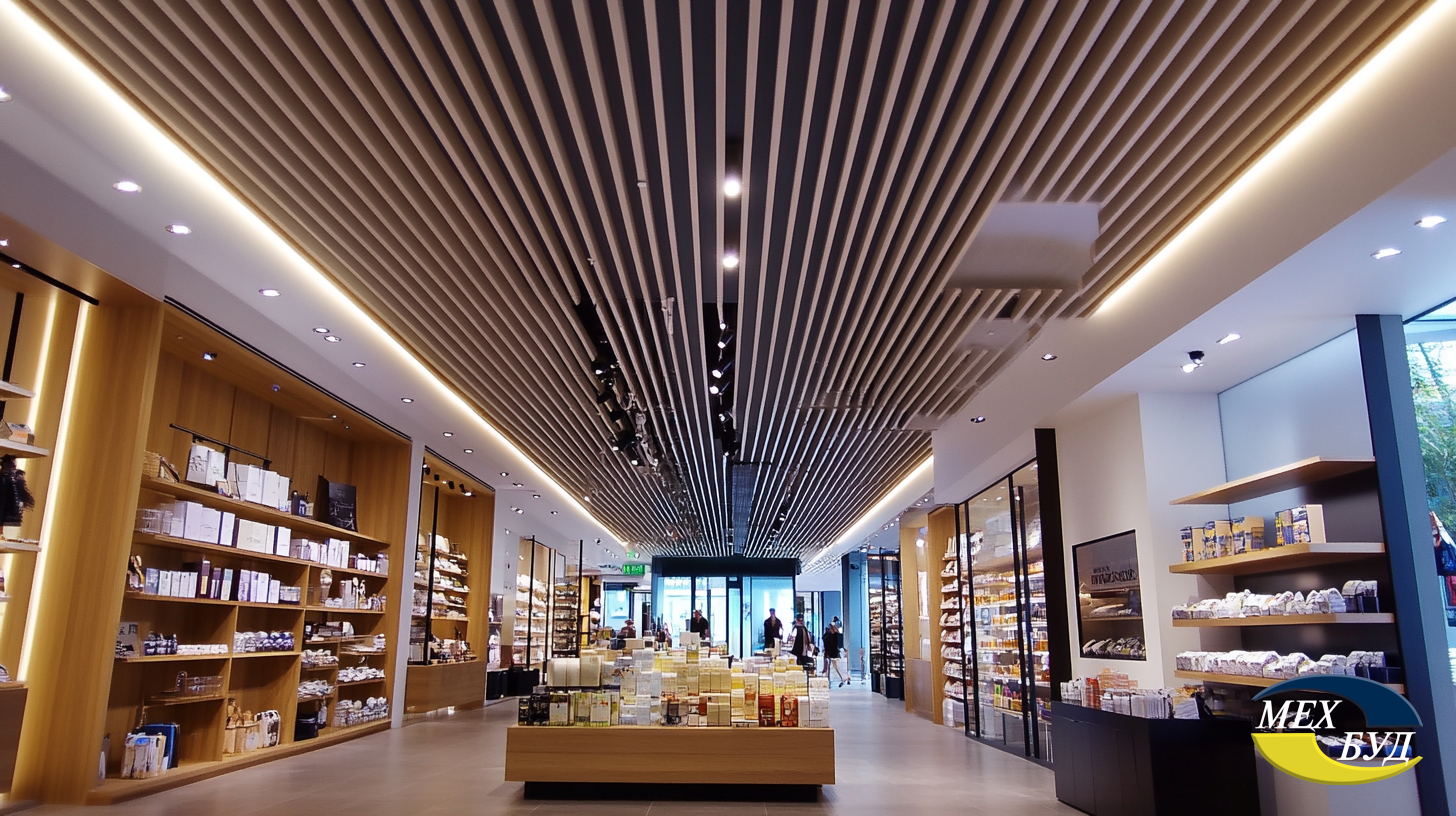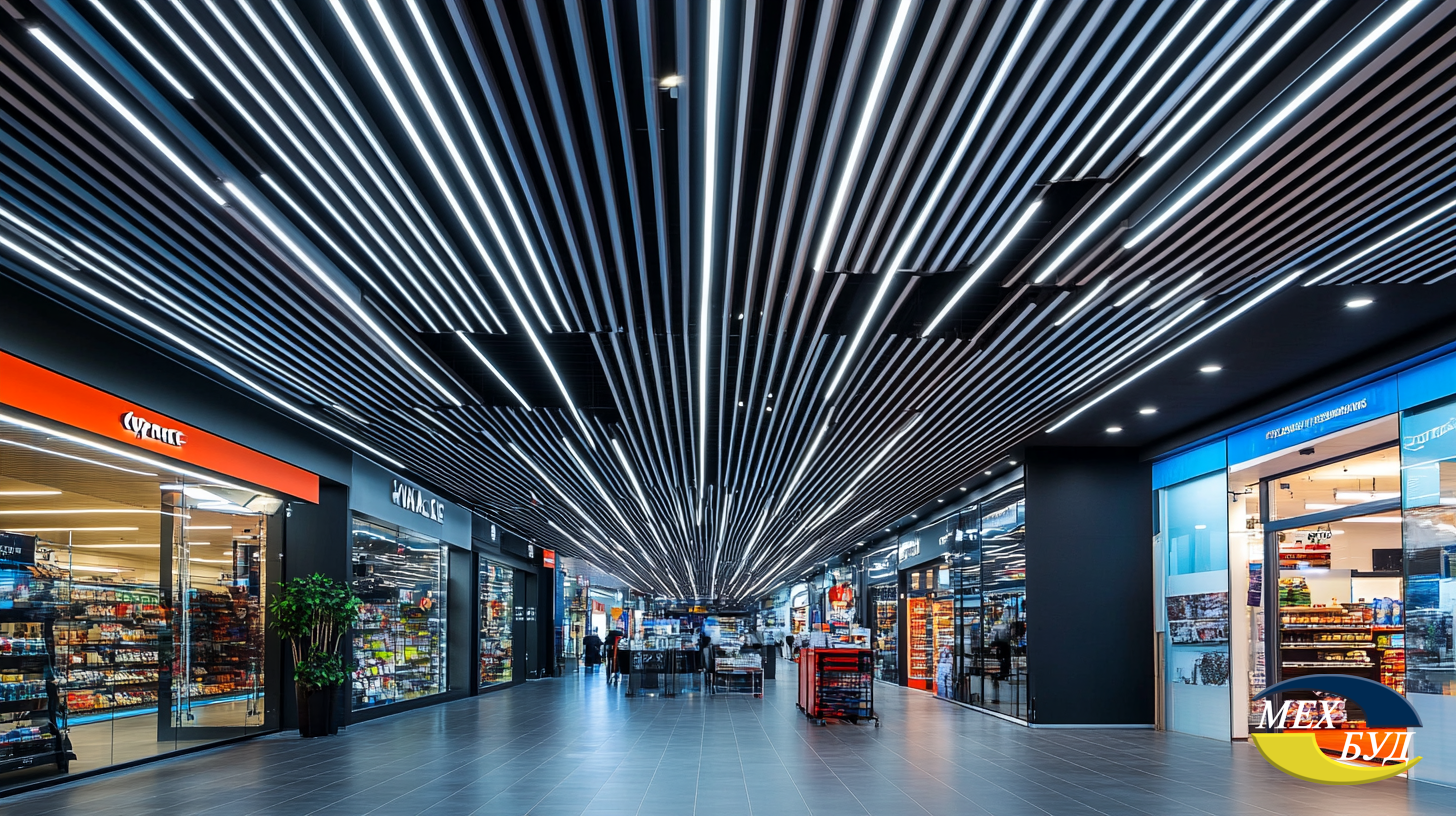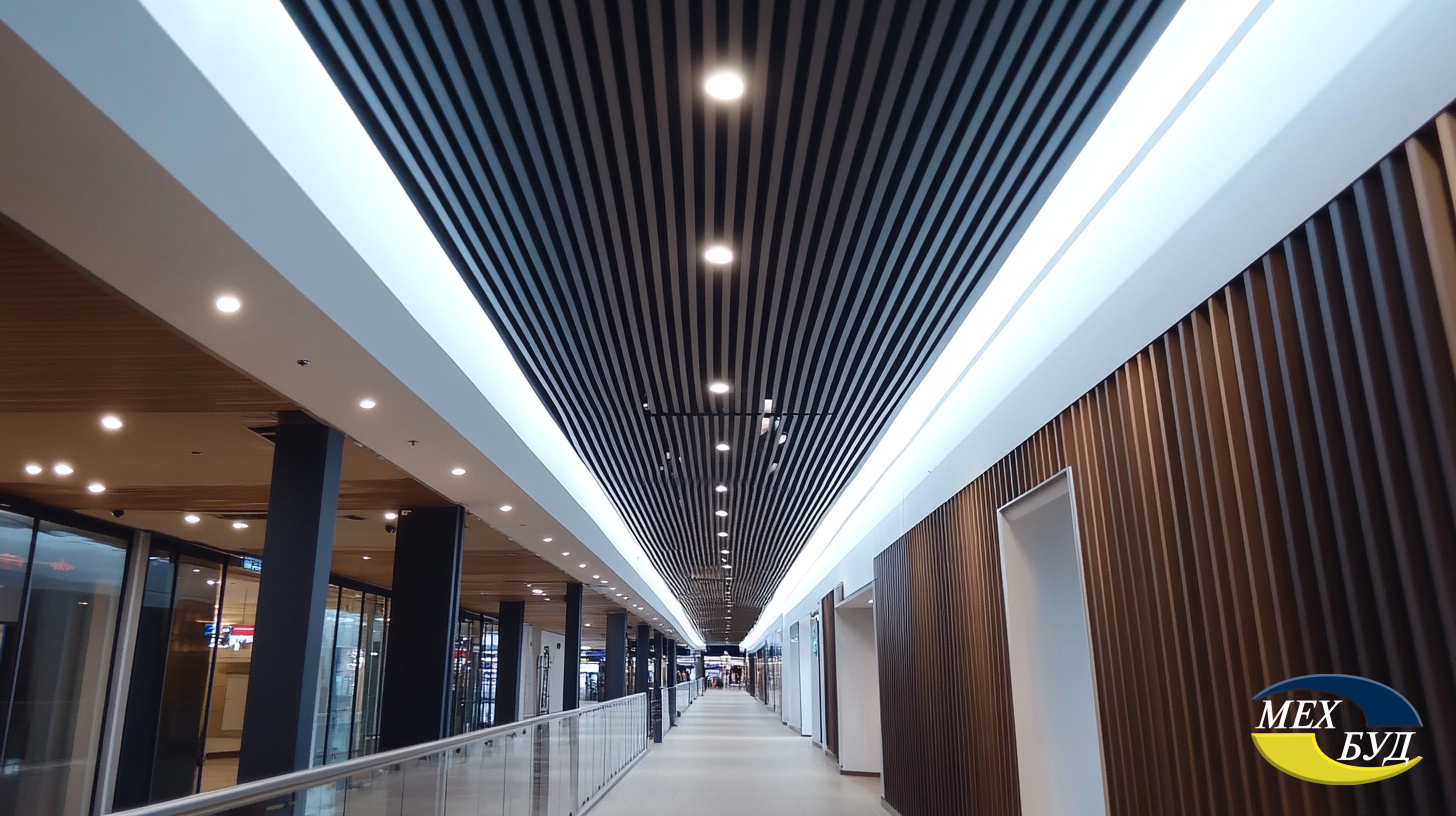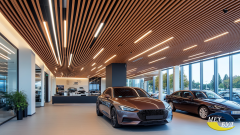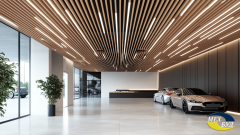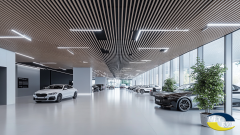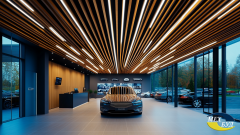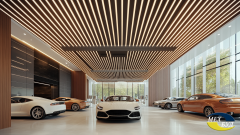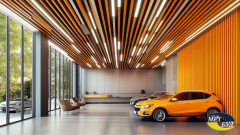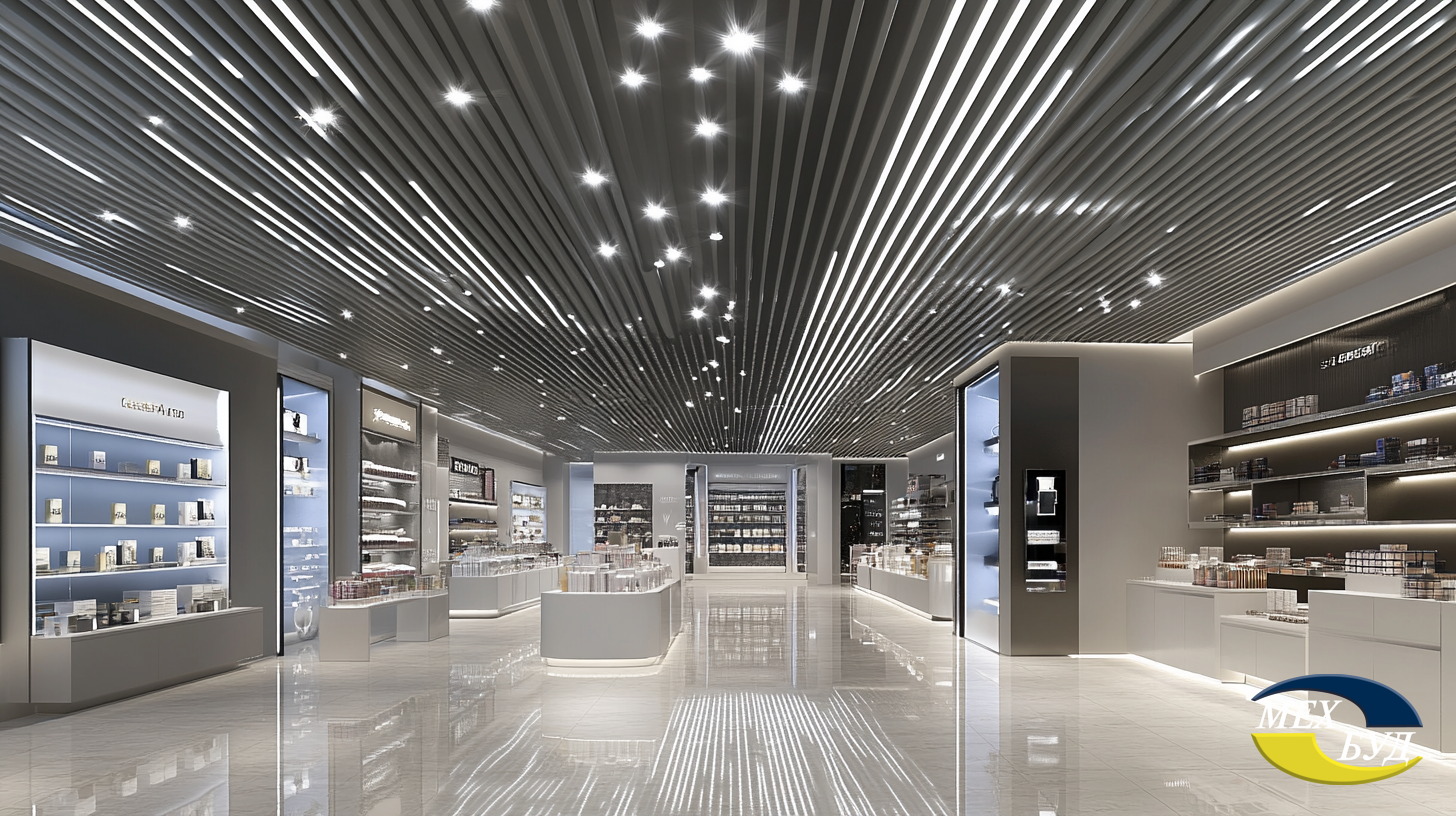Applications: Metal Ceilings in Different Types of Showrooms
One of the strengths of metal ceiling systems is their suitability for all types of product showrooms. Different retail sectors have unique requirements and stylistic tendencies, and metal ceilings are flexible enough to accommodate them. Below, we consider a few key showroom categories and how metal ceiling designs are applied in each:
Automotive Showrooms
Car dealerships and automotive showrooms typically feature expansive floor areas, high ceilings, and the need for very bright lighting to showcase vehicles. Metal ceilings are practically tailor-made for these environments. Many auto showrooms opt for large-format metal panels or open-grid ceilings that complement the sleek lines of modern cars. A common design is a white metal panel ceiling with recessed LED downlights spaced evenly to eliminate shadows on the cars. The metallic surface can even add a slight reflective quality, giving the space a brighter feel as light bounces off. In luxury car showrooms, we often see reflective chrome or aluminum finishes in the ceiling to evoke a high-tech, premium atmosphere. Additionally, linear strip lights integrated into metal slatted ceilings can create a dynamic, runway-like illumination across the showroom — perfect for highlighting a row of automobiles.
From a functional perspective, the high durability of metal ceilings holds up well against the indoor climate control of large glass-walled showrooms (where humidity and temperature fluctuate). They also allow easy access to the myriad of wiring for specialty lighting, sound systems, and security cameras often installed in dealerships. Some car retailers even incorporate brand-specific design elements; for example, a BMW showroom might use a crisp aluminum ceiling to mirror its minimalistic German engineering ethos, whereas a Ferrari showroom could feature sections of red accent panels in the ceiling to reflect the brand’s signature color. In Ukraine, several new auto dealerships have embraced metal ceiling systems for their combination of aesthetic impact and longevity. These ceilings send a message of modernity and innovation the moment a customer walks in to see the latest car models.
Retail Boutiques and Flagship Stores
Whether it’s a fashion boutique, an electronics outlet, or a cosmetics flagship store, retail showrooms aim to create immersive brand experiences. Metal ceilings help these spaces stand out while meeting practical needs. In upscale fashion boutiques, for instance, designers might choose a decorative metal ceiling that complements the store’s theme — such as a gold-toned perforated pattern to add texture and luxury in a high-fashion apparel shop. A great example is a vibrant clothing showroom (internationally) that used a ceiling of perforated metal with bold, uniform circles, achieving a sense of cohesion and playful energy in the space. Such a ceiling becomes part of the visual merchandising, framing the products below in a unique light.
For tech and electronics stores, metal ceilings provide that contemporary, tech-savvy look consumers expect. Imagine a smartphone brand’s showroom with a futuristic aluminum ceiling, complete with geometric cut-outs and integrated LED strips that glow in the brand’s colors — it reinforces the high-tech product offerings. Additionally, retail stores often have to consider acoustics, especially when they play music. By using acoustic metal ceiling tiles (with micro-perforations and insulation backing), a boutique can maintain a lively yet not overwhelmingly noisy environment, even during peak hours.
Another advantage in retail is the ease of reconfiguration: stores change layouts and displays seasonally, and a modular metal ceiling can adapt by allowing lights or fixtures to be relocated without leaving marks (panels can be swapped or modified as needed). In Ukraine, many mall stores and independent shops have started installing metal ceilings not only because they look stylish, but also to leverage these practical perks. They’ve found that a well-designed ceiling elevates the brand perception — customers subconsciously associate the polished, modern interior with a professional and high-quality operation, which can increase trust and willingness to buy.
Furniture and Home Design Showrooms
Furniture, kitchen, and home décor showrooms often resemble large galleries, showcasing various styled vignettes of living spaces. These venues benefit from ceilings that are neutral yet sophisticated, as they need to highlight furniture setups without clashing or distracting. Metal ceiling systems in matte finishes or with wood-look textures are popular choices here. For example, a furniture showroom might use an off-white or light grey metal ceiling with a tegular tile design (a grid where panels drop slightly to create shadow lines). This provides a clean backdrop that makes furniture pieces stand out while still looking more refined than a basic drywall ceiling.
Alternatively, sections of a home design showroom — say the kitchen displays — might feature a woodgrain-finished metal ceiling to give a warmer, homier vibe above the model kitchens, all while remaining non-flammable near demonstration cooktops. Another consideration is the height and openness of these spaces; furniture warehouses converted to showrooms often have exposed beams or very high ceilings. Rather than leave everything exposed (which can look too industrial for a home setting), owners install suspended metal ceilings at a lower level to create a more intimate scale for customers. Wire mesh ceilings are an interesting solution seen in some large home stores, where a brass or black mesh is suspended to hide ductwork but still keep an open feel. This adds an instant industrial-chic character that pairs well with both modern and rustic furniture displays.
In Ukraine, a number of home improvement and furniture centers (including sections of big-box stores) have adopted metal ceilings because they can be configured to any store layout and allow easy hanging of signage or ceiling-mounted décor. And when those stores eventually remodel or expand, the metal ceiling can often be reconfigured or augmented rather than entirely demolished, demonstrating their adaptability.

